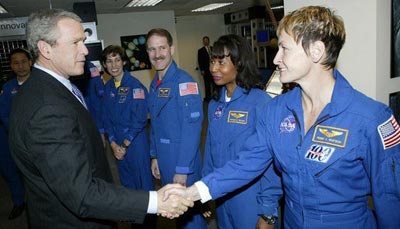Can Bush really do it?by Taylor Dinerman
|
| It is commonplace to claim that the first Bush’s Moon/Mars proposal was killed because of NASA’s $450 billion price tag. It fact, that is a bit of a canard. |
Opposition to this program seems to be pretty tame compared to 1989. Al Gore said that we should make Earth habitable before we go to Mars. A few other Democrats made similar statements, but others, such as Nick Lampson of Texas, came out more or less in support of the President. More important, many others stayed quiet. This may mean they are waiting to ambush the President on this, it may indicate acquiescence, or it may just mean that they are out of power and want to save their energies for more important issues.
Congress is in Republican hands and is likely to remain so for the next three years. There is little chance that this Administration’s proposal will be rejected out of hand. It is commonplace for space commentators to claim that the first Bush’s Moon/Mars proposal was killed because of NASA’s $450 billion price tag. It fact, that is a bit of a canard. The Democrats who controlled Congress in 1989 were a highly intelligent and experienced group of political animals who were not about to allow a GOP President to have any historic accomplishments to his credit, at least not if they could help it. They could not stop the Berlin Wall from coming down nor could they prevent the liberation of Kuwait, but they could make sure that in 2020 or whenever, there would be no George Herbert Walker Bush TV clip to match the JFK “We choose to go to the Moon!” one.
In 2004, neither the Speaker of the House, nor the Majority Leader of the Senate, nor the chairmen of the appropriation committees in either house have such an incentive. Congress will carefully examine the proposal and will almost certainly modify it, but it will not eviscerate it. This is an election year and if Bush and the GOP leadership try to reach out to the Democrats they will not find them in a receptive mood. However, if Bush makes a real effort to bring Democrats on board, it could pay off in the long run.
The bureaucracy may kill this program using lack of enthusiasm and through unthinking allegiance to certain technological rice bowls such as the space shuttle. NASA had been planning to fly the shuttle until as late as 2025. Now, it faces the fact that it will make its last flight in 2010. Those who had planned their careers and their lives around the 2025 date will be devastated. This is going to be a tricky human resources problem for NASA and for its contractors. The agency could use the shuttle’s solid rocket boosters and main fuel tank with rocket engines attached, but without the orbiter, as Buzz Aldrin and his team have proposed. This would certainly save thousands of jobs.
The key to the whole plan is affordability. As long as NASA’s total budget does not exceed $20 billion before 2014 and stays at roughly that level afterwards then building the moonbase and beginning serious work on the Mars mission is possible. The problems will be similar to those that plagued the “faster better cheaper” approach. If the project is done to a tight schedule, then reaching its ambitious goals will be pretty expensive. If the schedule is allowed to slip, total program costs will be driven up. Getting the balance right while at the same time providing enough reserve funds to cover the inevitable is going to be the hardest thing for NASA’s planners to deal with.
| The bureaucracy may kill this program using lack of enthusiasm and through unthinking allegiance to certain technological rice bowls such as the space shuttle. |
The design for the new CEV is very much up in the air. The contractors not only have to come up with a system that fits the requirements, but they also have to discern what NASA really wants. This is a like trying to figure out what a papal conclave really wants in a new pope from the configuration of the cardinals’ seating arrangements. Do they want a spaceplane? A capsule? Something in between? Does the agency want something that will only fit on top of an EELV or do they want something that could ride on a two stage to orbit RLV? So far NASA is not saying.
Giving the contractors lots of so called “trade space” may seem like a good idea but, in fact, the sooner they come up with a clear set of guidelines the sooner the contractors can get to work on a design that represents something NASA will actually want to fund, rather than wasting their efforts on fanciful concept studies. The moment of decision is fast approaching. If Admiral Steidle makes the right choice, then the President’s program will succeed. If not, then America will once again be made to pay the price. The best we can hope for is that the administration will give Steidle the chance to make the decision without political interference.
